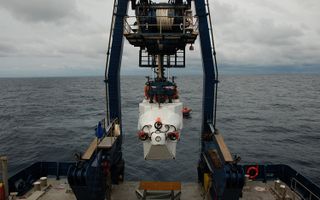85 Miles of Atlantic Coral Reef Stayed Hidden Until Now

For thousands of years — perhaps hundreds of thousands — a sizable coral reef has stretched across the seafloor in the Atlantic Ocean, near the southeastern part of the U.S. And its existence remained a well-hidden secret until a recent deep-sea expedition brought the thriving ecosystem to light.
Scientists on board the research vessel (RV) Atlantis discovered the reef last week, about 160 miles (257 kilometers) off the coast of Charleston, South Carolina, the HuffPost reported. Cameras on a submersible deployed from Atlanis — the human-operated vehicle (HOV) Alvin — captured the unexpected sight of dense, cold-water coral populations seeding the sea bottom about 0.5 miles (0.8 km) below the ocean surface.
The site was covered with living corals — "just mountains of it" — growing atop the massive, skeletal remains of dead corals that had likely been inhabiting the area for millennia, expedition lead scientist Erik Cordes, an associate professor in the Department of Biology at Temple University in Philadelphia, told the HuffPost. [In Photos: Diving in a Twilight Coral Reef]
Scientists used Alvin to explore the reef and collect coral samples during dives on Aug. 23 and Aug. 24, according to the HuffPost. The researchers discovered copious amounts of Lophelia pertusa, a branching, whitish coral that prefers cold waters and that has previously been found growing at record depths in the Gulf of Mexico.
While tropical corals typically rely on symbiotic algae to survive, L. pertusa does not, and it uses stinging tentacles to stun its prey and guide food into its stomach, according to the National Oceanic and Atmospheric Administration (NOAA).

Corals detected by the Atlantis were found about 16 miles (26 km) to the northwest of corals found earlier this summer by the NOAA RV Okeanos Explorer, which was mapping hundreds of seamounts on the ocean floor, HuffPost reported. Together, the coral-covered area explored by Okeanos and the Atlantis extends for an estimated 85 miles (137 km), layered with enormous, rocky piles of dead coral that likely accumulated over many thousands of years, Cordes told HuffPost.
The RV Atlantis embarked on its 15-day expedition on Aug. 19, part of a 4.5-year collaborative project known as the Deep Sea Exploration and Research of Coral/Canyon/Cold seep Habitats (Deep SEARCH), according to the mission website.
Sign up for the Live Science daily newsletter now
Get the world’s most fascinating discoveries delivered straight to your inbox.
Until Sept. 2, scientists on the Atlantis will explore deep-sea habitats near the southeastern coastal U.S. They will collect critical data on the distribution of ecosystems and wildlife of the sea bottom in order to more accurately predict how these fragile communities could be disrupted by human activity, NOAA reported on the Deep SEARCH website.
Original article on Live Science.

Mindy Weisberger is an editor at Scholastic and a former Live Science channel editor and senior writer. She has reported on general science, covering climate change, paleontology, biology, and space. Mindy studied film at Columbia University; prior to Live Science she produced, wrote and directed media for the American Museum of Natural History in New York City. Her videos about dinosaurs, astrophysics, biodiversity and evolution appear in museums and science centers worldwide, earning awards such as the CINE Golden Eagle and the Communicator Award of Excellence. Her writing has also appeared in Scientific American, The Washington Post and How It Works Magazine.
Most Popular

